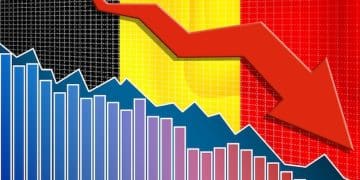Inflation Update: CPI Shows Slight Increase, What It Means for You

The Consumer Price Index (CPI) recently showed a slight increase of 0.1%, signaling ongoing inflation concerns and potential impacts on consumer spending and the overall economy.
The latest Inflation Update: Consumer Price Index Shows Slight Increase of 0.1%, revealing a mixed bag of economic signals. While seemingly small, this uptick raises questions about the effectiveness of current monetary policies and its implications for everyday Americans.
Understanding the Consumer Price Index (CPI)
The Consumer Price Index, or CPI, is a critical economic indicator that measures the average change over time in the prices paid by urban consumers for a basket of consumer goods and services. It’s essentially a snapshot of inflation from the consumer’s perspective.
Understanding the CPI involves grasping its components, how it’s calculated, and what it signifies for the economy. This knowledge is essential for making informed financial decisions.
Components of the CPI
The CPI encompasses a wide array of goods and services, categorized into major groups such as:
- Food and beverages
- Housing
- Apparel
- Transportation

Each category is weighted according to its relative importance in the average consumer’s spending patterns. This weighting ensures that the CPI accurately reflects the overall price changes experienced by consumers.
How the CPI is Calculated
The Bureau of Labor Statistics (BLS) is responsible for calculating the CPI. They collect price data from thousands of retail stores, service establishments, rental units, and doctors’ offices across the country. The data is then aggregated and weighted to produce the CPI.
The CPI is calculated using a base year, which is periodically updated to reflect current spending patterns. The current base period is 1982-84=100. The CPI for a given period is expressed as an index number relative to this base period.
In conclusion, the CPI is a comprehensive measure of consumer price changes, composed of various categories weighted by their importance in consumer spending, and calculated by the BLS using extensive price data.
The Latest CPI Increase: A Closer Look at the Numbers
The recent Inflation Update: Consumer Price Index Shows Slight Increase of 0.1%, but what does this actually mean? Let’s break down the numbers and understand the key factors contributing to this change.
This section will delve into the specific categories that experienced price increases, potential reasons behind these increases, and a comparison with previous months’ data.
Categories with Notable Price Increases
Several categories within the CPI contributed to the recent increase. These may include:
- Energy: Fluctuations in oil prices can significantly impact the CPI, particularly transportation and home heating costs.
- Food: Supply chain disruptions, weather events, and increased demand can all lead to higher food prices.
- Housing: Rising rents and home prices contribute to the overall CPI.
Analyzing these categories helps pinpoint the primary drivers of the latest CPI increase.
Potential Reasons Behind the Increase
Several factors could be contributing to the recent CPI increase, such as:
Supply chain bottlenecks: Ongoing disruptions can limit the availability of goods, leading to higher prices.
Increased demand: As the economy recovers, consumer spending may outpace supply, driving up prices.
Monetary policy: The Federal Reserve’s monetary policy decisions, such as interest rate adjustments, can influence inflation.
The interplay of these factors can create a complex inflationary environment.
Month-over-Month Comparison
Comparing the latest CPI data with previous months provides valuable context. Is the current increase a blip or part of a sustained trend?
Looking at month-over-month changes in specific categories can reveal whether price increases are accelerating, decelerating, or remaining stable.
In summary, a closer examination of the latest CPI increase involves identifying categories with notable price changes, understanding potential contributing factors, and comparing the data with previous months to assess the overall inflationary trend.
Impact on Consumers: How Does This Affect Your Wallet?
The Inflation Update: Consumer Price Index Shows Slight Increase of 0.1% directly affects consumers’ purchasing power and financial well-being. Understanding these effects is crucial for making informed financial decisions.
This section will explore how the CPI increase impacts everyday expenses, purchasing power, and the potential need for budget adjustments.

Impact on Everyday Expenses
A CPI increase translates to higher prices for goods and services, directly impacting everyday expenses such as:
- Groceries: Higher food prices mean you’ll pay more for the same items at the grocery store.
- Gasoline: Increased energy costs lead to higher prices at the pump.
- Utilities: Rising prices for electricity, natural gas, and other utilities impact your monthly bills.
These increased expenses can strain household budgets and reduce discretionary spending.
Purchasing Power
Inflation erodes the purchasing power of your money. As prices rise, each dollar buys less than it did before.
This means that even if your income stays the same, you may not be able to afford the same goods and services due to inflation.
Budget Adjustments
To cope with the impact of inflation, consumers may need to make budget adjustments such as:
Cutting back on non-essential spending.
Finding ways to save on groceries, transportation, and utilities.
Seeking wage increases or additional income opportunities.
Reassessing your budget and making necessary adjustments can help mitigate the impact of inflation on your finances.
In conclusion, a CPI increase impacts consumers by raising everyday expenses, eroding purchasing power, and potentially requiring budget adjustments to maintain financial stability.
The Federal Reserve’s Response to Inflation
The Federal Reserve (also known as The Fed) plays a critical role in managing inflation through monetary policy. The Fed’s actions can significantly impact the economy and influence the trajectory of inflation.
This section will examine the Federal Reserve’s tools for controlling inflation, potential policy decisions in response to the latest CPI data, and expert opinions on the Fed’s actions.
Tools for Controlling Inflation
The Federal Reserve has several tools at its disposal to control inflation, including:
Adjusting the federal funds rate: This is the target rate that banks charge each other for the overnight lending of reserves.
Setting the reserve requirements: This is the fraction of a bank’s deposits that they are required to keep in their account at the Fed or as vault cash.
Conducting open market operations: This is the buying and selling of U.S. government securities by the Fed.
Potential Policy Decisions
In response to the Inflation Update: Consumer Price Index Shows Slight Increase of 0.1%, the Federal Reserve may consider the following policy decisions:
Raising interest rates: This can help cool down the economy and reduce inflationary pressures.
Continuing quantitative tightening: This involves reducing the Fed’s balance sheet by allowing Treasury securities and agency mortgage-backed securities to mature without reinvesting the proceeds.
Maintaining the current policy: The Fed may choose to wait and see how the economy responds to previous policy changes before taking further action.
The Fed’s policy decisions will depend on its assessment of the economic outlook and the risks to price stability.
Expert Opinions on the Fed’s Actions
Economists and financial analysts often have differing opinions on the Federal Reserve’s policy decisions. Some may argue that the Fed is too aggressive in tightening monetary policy, while others may believe that it is not doing enough to combat inflation.
Following expert commentary and analysis can provide valuable insights into the potential consequences of the Fed’s actions.
In summary, the Federal Reserve plays a crucial role in managing inflation through monetary policy tools. Its policy decisions in response to the latest CPI data will depend on its assessment of the economy and expert opinions often vary on the effectiveness and appropriateness of the Fed’s actions.
Strategies for Protecting Your Finances During Inflation
Inflation can erode your savings and investment returns. Implementing strategies to protect your finances is essential during inflationary periods.
This section will explore investment options that can help hedge against inflation, strategies for managing debt, and tips for negotiating prices and saving money.
Investment Options
Several investment options can help protect your wealth during inflation, such as:
- Treasury Inflation-Protected Securities (TIPS): These bonds are indexed to inflation, meaning their principal value increases as inflation rises.
- Real estate: Historically, real estate has been a good hedge against inflation, as property values and rental income tend to increase during inflationary periods.
- Commodities: Investing in commodities like gold, oil, and agricultural products can provide a hedge against inflation, as their prices tend to rise when inflation increases.
Managing Debt
Managing debt effectively is crucial during inflation. Consider the following strategies:
Paying down high-interest debt: Focus on paying off credit card debt and other high-interest loans as quickly as possible.
Refinancing debt: If possible, refinance variable-rate loans into fixed-rate loans to protect yourself from rising interest rates.
Avoiding unnecessary debt: Avoid taking on new debt unless it is absolutely necessary.
Negotiating Prices and Saving Money
During inflationary times, it’s important to be proactive in negotiating prices and finding ways to save money. Here are some tips:
Shop around for the best prices: Compare prices at different stores and online retailers before making a purchase.
Negotiate prices: Don’t be afraid to negotiate prices, especially on big-ticket items.
Use coupons and discounts: Take advantage of coupons, discounts, and loyalty programs to save money.
Cut back on non-essential spending: Identify areas where you can reduce your spending without sacrificing your quality of life.
In conclusion, protecting your finances during inflation involves diversifying investments, managing debt effectively, and actively seeking ways to negotiate prices and save money.
Long-Term Economic Outlook
The Inflation Update: Consumer Price Index Shows Slight Increase of 0.1% raises questions about the long-term economic outlook. Understanding potential scenarios and their implications is crucial for businesses and individuals.
This section will explore potential long-term scenarios and their implications, the role of government policies, and strategies for businesses to navigate inflation.
Potential Scenarios and Implications
Several long-term scenarios could unfold depending on how inflation evolves:
- Scenario 1: Transitory inflation: Inflation proves to be temporary and subsides as supply chain issues are resolved and demand normalizes.
- Scenario 2: Persistent inflation: Inflation remains elevated for an extended period, requiring more aggressive monetary policy intervention.
- Scenario 3: Stagflation: The economy experiences both high inflation and slow economic growth, creating a challenging environment for businesses and consumers.
Each scenario has different implications for businesses, consumers, and investors.
Role of Government Policies
Government policies can play a significant role in shaping the long-term economic outlook. Policies that promote:
Increased productivity: Investments in education, infrastructure, and technology can boost productivity and help offset inflationary pressures.
Fiscal responsibility: Reducing government debt and deficits can help stabilize the economy and reduce inflation.
Competition: Promoting competition in various industries can help keep prices in check.
Strategies for Businesses
Businesses can implement several strategies to navigate inflation, such as:
Raising prices: Businesses may need to raise prices to offset increased costs, but they should do so strategically to avoid losing customers.
Improving efficiency: Finding ways to reduce costs and improve efficiency can help businesses maintain profitability during inflation.
Diversifying supply chains: Diversifying supply chains can reduce reliance on specific suppliers and mitigate the impact of supply chain disruptions.
| Key Point | Brief Description |
|---|---|
| 📊 CPI Increase | The CPI rose slightly by 0.1%, indicating continued inflation. |
| 💰 Impact on Consumers | Everyday expenses increase, reducing purchasing power. |
| 🏦 Fed’s Response | The Federal Reserve may adjust interest rates to manage inflation. |
| 🛡️ Financial Protection | Invest in TIPS, manage debt, and negotiate prices. |
FAQ Section
▼
The CPI is a measure of the average change over time in the prices paid by urban consumers for a basket of consumer goods and services, reflecting inflation’s impact.
▼
A CPI increase means higher prices for everyday expenses, potentially reducing your purchasing power and requiring adjustments to your budget to cope.
▼
Consider investing in inflation-protected securities, managing your debt, and negotiating prices to save money on essential purchases during inflationary periods.
▼
The Federal Reserve may raise interest rates or reduce its balance sheet to cool down the economy and combat inflationary pressures, affecting borrowing costs.
▼
Stagflation is a situation where an economy experiences both high inflation and slow economic growth simultaneously, creating difficult conditions for businesses and consumers.
Conclusion
The slight increase in the Consumer Price Index serves as a reminder of the ongoing challenges posed by inflation. By understanding its impact and implementing proactive financial strategies, consumers and businesses can better navigate the complexities of the current economic environment and prepare for future uncertainties.






